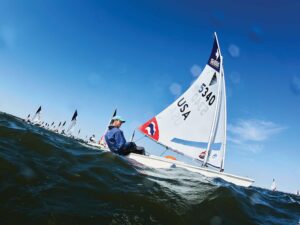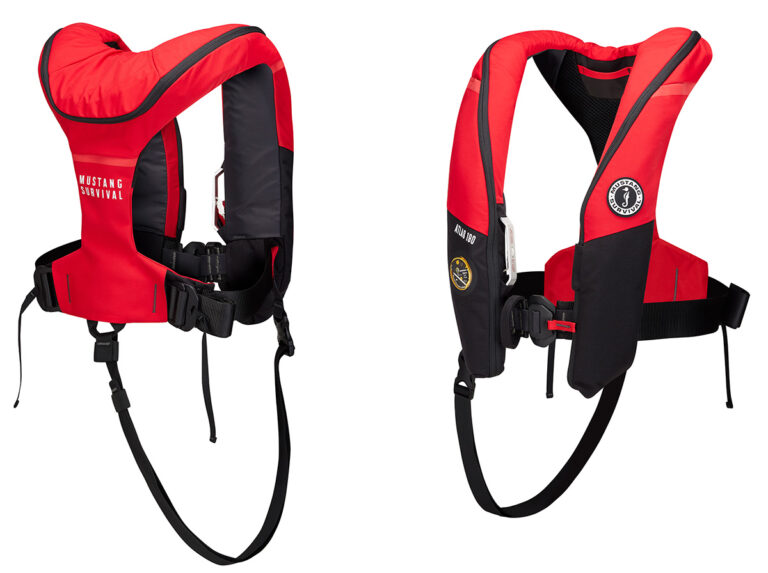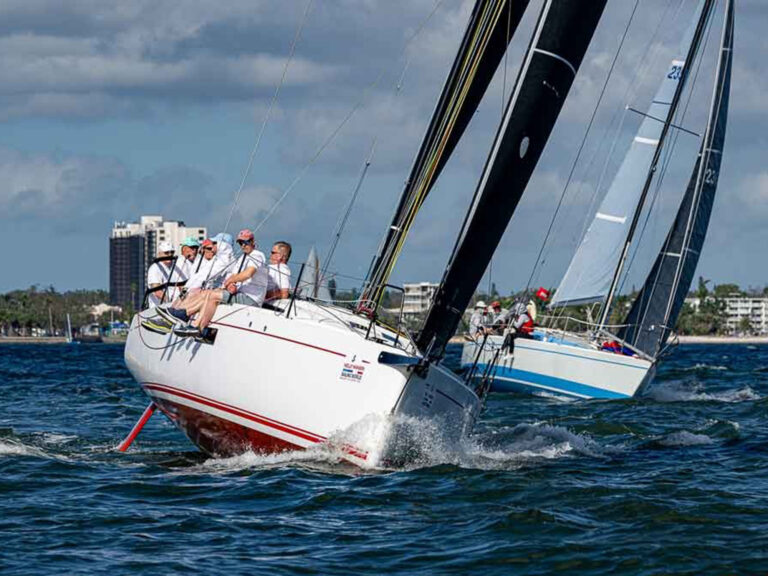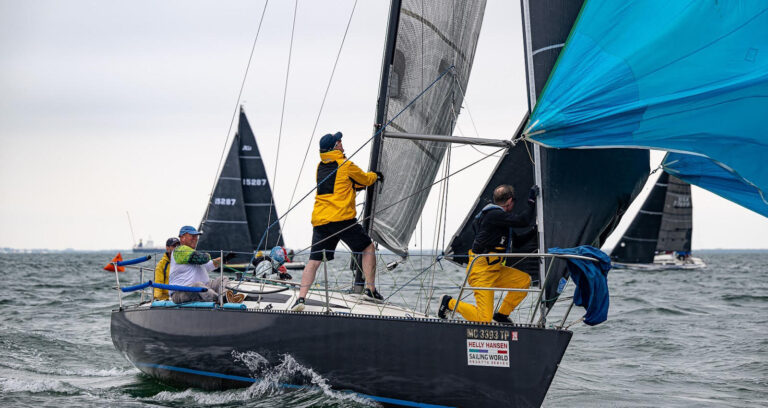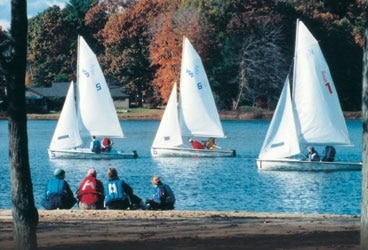
It wasn’t the Rose Bowl, but Amherst College¿s first home regatta, held on Arcadia Lake in October 1999, was a momentous occasion for all in attendance.
Unfortunately for college sailing, the best means of recruiting prospective college sailors might be the monthly rankings that appear in this magazine. Since the sport gets very little publicity, and many college sailing teams are run on a shoestring with little time or money for active recruiting, the Sailing World collegiate rankings are a primary source of information about college sailing programs. Because of this, many up-and-coming scholastic sailors mistakenly think that to get the most out of their college sailing experience, they must attend one of the few powerhouse programs.
“The perception among junior sailors is, if you’re a good sailor and want to be big in college sailing, you’ve got to go to one of the top few schools,” says Dan Winters, the head coach at Christopher Newport. “The names that keep showing up in Sailing World in the top 20 are the ones on the kids’ minds.”
On the surface, the evidence seems to support this point of view. Sailing varsity for Tufts, Charleston, or St. Mary’s is about as close as one can get to a guaranteed spot on the Intercollegiate Yacht Racing Association All-America list. From 1995 through 1999, those three schools earned a third (39 of 115) of the All-America honors given out by the ICYRA and won 11 national titles.
It’s important to remember, however, that each of these schools annually attracts a bevy of junior rock stars, some of whom sit on the bench for three years before earning a chance to start or who grow disillusioned long before they get the chance to strut their stuff in an intersectional. It takes only four good sailors to win a national coed or women’s dinghy title, and there are over 150 schools recognized by the ICYRA, collegiate sailing’s governing body. Many of these schools are just one or two great sailors away from a top-10 national ranking.
In addition, the values of college sailing go well beyond the results. Team trophies and individual honors are, in many cases, a small part of the overall experience.
As a team captain and high-school team racing champion at Tabor Academy, Andy Horton had the skills and grades to get into and sail for most schools in the country. However, having grown up in northern Vermont and carrying a fairly thin junior-sailing resume, he fell just below the radar of the few college coaches with the resources to recruit incoming talent. Rather than fight his way through the pack at a power school, Horton took a chance on a fledgling program and attended Hobart and William Smith Colleges in upstate New York.
“I like to work hard, and Scott [Ikle, HWS coach] said he could help out,” Horton says. “I thought I’d have a better chance of doing what I wanted to do than if I went to a place where success is expected.” Horton, who’s now in the midst of an Olympic Soling campaign, sailed nearly every intersectional regatta HWS over for four years. He earned All-America honors three times and finished his career with a third-place finish in A Division at the 1998 Dinghy Nationals. He also played a key role in building what’s now one of the stronger teams in the country, an experience that would’ve been difficult to find at a school that’s been ranked in the top 20 for the past decade.
This is what lies behind the rankings and race results: the part of college sailing that’s rarely written about but is for many the most memorable. Collegiate sailing has always depended on student involvement in the day-to-day operations both of individual teams and the ICYRA as a whole. Initially this was a necessity. Few teams had the money to hire a coach, even on a part-time basis, so everything from boat maintenance to regatta scheduling to running practices was done by the team members. During the last few decades, sailing has edged closer to other college sports in terms of funding and coaching. Even so, some of the programs with the funding to be run like a Division I football team still cling to the cooperative spirit upon which college sailing was built.
“Our team captains run tryouts,” says coach Adam Werblow, whose St. Mary’s College team is one of the better-supported in the nation. “It’s our team captains who decide what’s going to happen there. I do this because of my experience as a student at Connecticut College. We were a student-run team, and I thought there was some value in some of the things we did at Conn. I wanted to combine the best elements of both.”
For many teams this autonomy-though at St. Mary’s, Werblow says he still makes the big decisions-is not a choice. Countless collegiate sailing teams are run virtually independent of any “adult” leadership, leaving the success or failure of the squad in the hands of the team members. Of course, this does have a downside. Numerous teams, like the Colby squad of the late 1980s, that left its JY-15s moored in Great Pond during a typically frigid Maine winter, have faded or disappeared completely because the energetic souls who kept the programs going graduated, leaving the teams in the hands of ill-prepared or unmotivated successors.
But there are as many triumphs as there are failures. Stories abound of programs in which victory is measured not in medals or postseason honors but in personal growth, long-lasting friendships, and sunny fall days spent on the water. (Colby has resurrected its program and, despite the misgivings of the administration, which seemed to hold the current students responsible for incidents that happened when they were still learning their multiplication tables, recently raised enough money to buy a fleet of six used Larks.)
In Peter Beardsley’s first semester at Amherst College in Amherst, Mass., the sailing team had one boat, held three practices, and attended one regatta. This past fall, just two years later, the Amherst squad practiced regularly in a fleet of eight 420s and attended more than 20 regattas, including four intersectionals. Beardsley, who is both team captain and volunteer coach, says he spends about 30 hours a week running the team and often has to sacrifice his own practice time to help instruct his teammates. Breaking into the top five in the New England Intercollegiate Sailing Association and qualifying for nationals is a difficult task, and Amherst isn’t likely to reach that level before Beardsley, a junior, dons a cap and gown and walks across a stage and into the real world. But the native of New Rochelle, N.Y., has long since realized there’s more to success than a spot in the rankings or a trip to nationals. In fact, what he’s learned running the team may prove to be more helpful in the future than a spot on the All-America list.
“Sometimes it can be frustrating out there because we’re sailing against Dartmouth, Connecticut College, and Boston College, and they have great programs,” Beardsley says. “I don’t think we’re ever going to have that caliber of team here. But all I want is for the people who race to at least constantly improve. The thing I looked for last spring was, I always wanted to do better in the last race than in the first race. If I had gone to a larger school that was more established, sure I would’ve developed more as a racer, but I don’t think I’d be as proud of what I’ve accomplished. I don’t know if I would’ve developed as much personally.”
Gilly Chamberlain, the team captain for the University of New Orleans, agrees. Chamberlain briefly attended the Coast Guard Academy, and he does, on occasion, pine for the seemingly unlimited funding of the Academy as well as the top-flight, easily accessible competition in NEISA. But he’s also quite proud of the work he’s done at UNO. Just three years old, the team qualified for two national championships last year-sloops and dinghies-and spent a few months at No. 20 in the Sailing World rankings.
“What bothered me was that a lot of guys who got All-American last year were from NEISA, and I was up there with those guys,” Chamberlain says. “I would’ve been a good sailor, but I wouldn’t have known how to run a team. I was really dependent on Al [Kruger, USCGA’s head coach]. I’ve learned so much about management. If you want to get something done in a business, you’ve got to deal with red tape.”
Though the team receives no regular funding from the school, Chamberlain was recently able to convince the UNO student government- “a lot of mean and ugly faces,” he recalls-to contribute $21,000 toward a fleet of six new 420s. Chamberlain’s struggle is typical of what teams have to deal with in the South-Eastern Intercollegiate Sailing Association, which is comprised essentially of schools from Texas and Louisiana. Almost all of the teams are student run, and funding is an annual battle, though of late it is a battle that a number of SEISA schools have been winning. In addition to UNO’s new fleet, Tulane, Baylor, Texas A & M-Galveston, and Texas all have new boats.
Performancewise, the schools in SEISA, like those in the Midwest (MCSA) and the Northwest (NWICYRA), are still lagging a step behind the better-funded teams in New England (NEISA), the Middle Atlantic (MAISA), the South Atlantic (SAISA), and California and Hawaii (PCIYRA), many of which have consistent coaching and varsity status.
While the view from the back of the fleet may not be so much fun at nationals, there are many sailors in the Midwest, Northwest, and South who are very happy with their situations.
“I’ve enjoyed the chance to sail Midwest regattas, which are more laid back and more oriented toward meeting the people in your district,” says Kathleen Clark, a junior at Michigan. “But we also do a lot of traveling out East which gives you more fierce competition and strengthens your team.” Clark says she was slightly burned out on sailing when she entered college and unsure of whether she even wanted to sail at the college level. But she found the mellower Midwest attitude was a perfect match for the amount of time and effort she wanted to commit to the team.
“I really wanted to go to Boston College. I had gotten in and talked to the sailing coach, but it was too much money,” Clark says. “I’m actually really glad I went to Michigan. If I went out there, I would’ve been under too much pressure to sail, and I wouldn’t have had the time to get involved in other things.”
The parity is also excellent in the Midwest, perhaps as good as any district in the nation. Last spring, five different schools qualified for the six berths at nationals allotted to the MCSA. Notre Dame was the only team to earn a double.
“The Midwest sticks together, but at the same time there are huge rivalries between the schools,” says Evangeline Callahan, a 1997 graduate of Old Dominion and a former volunteer coach for Northwestern. “They love to race, they love to sail, and they love to have a good time. They do it in horrible conditions, so they might as well be having a good time.”
The sacrifices willingly endured for the sport, from routinely sailing in near-freezing temperatures in NEISA and the MCSA to driving 15 hours each weekend to get to a regatta in SEISA and on the West Coast, might be the best measure of how much fun, enjoyment, and personal satisfaction can be gained from college sailing.
College sailing definitely requires some effort, often a lot of effort. For the smaller programs, this effort is rarely rewarded with medals or individual accolades. But few people will deny that even the intangible rewards are well worth the commitment.

